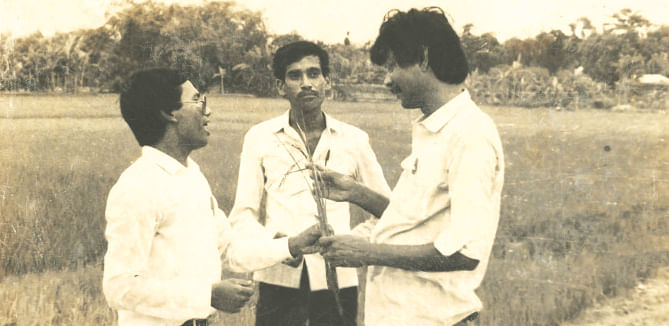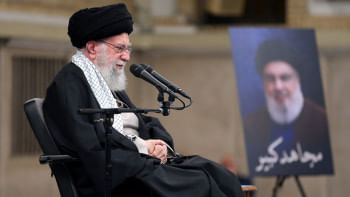The Dust Road of Monajatuddin

The constant traveler is on the move, perpetually. Now Rangpur, now Kurigram, now Dinajpur. Beneath his feet is entire North Bengal, and he treads the dust road fast, with a sense of urgency, ever alert. No, he is not running away from anything or hiding from life. Rather, he is out on the road to confront life head-on. He is out to look for the widow whose husband died of hunger, or the father whose teen daughter returned home after her third marriage broke, like the previous two, for failing to arrange dowry. Charon Sangbadik Monajatuddin is out looking for an entire village where the privileged few suck on the underprivileged many.
| Life Sketch |
| Monajatuddin was born in Rangpur on June 27, 1945, to Matijan Nesa and Alimuddin Ahmed. He passed matriculation from Rangpur Kolashranjon School and IA from Rangpur Carmichael College. Subsequently he obtained a BA degree. He started journalism from his student life but his career began with Bogra Bulletin in the 1960s. From 1972 to 1976, he was the correspondent of Dainik Purbadesh and Azad for the northern region. In 1976, he earned fame by sending reports to Dainik Sangbad as its correspondent for the northern region. In April 1995, he joined Dainik Janakantha. He died on December 29 that year. Notable books: Path Theke Pathe, Sangbad Nepathye, Kansonar Mukh, Shah Alam o Maziborer Kahini, Pairabander Shekor Sangbad and Lokkhitari. Notable awards: Zahur Hosen Gold Medal (1984), Philips Award (1993) and Ekushey Padak (1997). |
Throughout his career of over three decades, Monajatuddin made sure that the city people hear the cry of the eight northern districts and its ever neglected men, women and children. It was a lifelong mission he took it upon himself. And he showed us, singlehandedly, the otherwise unseen political rot, the social injustice, the venomous bite of dowry system and the multifaceted impact of misinformation on rural people.
This information gap is depicted in one of his stories vividly and rather humorously when an elderly woman in a northern village describes Khaleda Zia as “gormen” (government) and as that “Dhawla Fokfoka” (white and fair) lady. Of Sheikh Hasina, the woman says: Hachina coshma pinda tay khali rindia (India) jay.
It is not for nothing that his colleagues and senior journalists of the time named him Charon Sangbadik. He had one address and he would never forget that: the dust roads of northern districts he would take to again and again. Consider this: In 1982, he wrote a 13-part series report in daily Sangbad titled “Drishapat Chilmari,” accounting the many problems facing this Kurigram upazila. Twelve years later, in 1994, he went back there, now to report if lives in this impoverished area have changed. This report -- Chilmarir Ek Jug -- puts under spotlight the political hypocrisy. While it details how thousands of lives there have remained as they had been, it also pinpoints how reality is different from empty lip-service:
“In 1974, the near naked, fishing net-wearing Basanti-Durgati of Chilmari's Majhipara village had been dragged onto the political stage to blow out the political opponent. But still today, there has not been any change in the lives of the Basantis. The Basantis are still malnourished; they still wear fishing net-like tattered clothes. Several governments have come and gone and each of them promised time and again to change peoples' lives, but for Basanti, nothing has changed in these 20 years except that she has grown older.”
News in its conventional sense was never “news” for Monajatuddin. To him, news was what lay underneath. It is for this reason that his thrust is not on the deaths from hunger, but why that hunger in the first place. And very Monajatuddin-like, he finds out: Rice price has gone up in the north when work is scarce. It is also for this journalistic maxim that when he discovers Freedom Fighter Shah Alam begging on the Farmgate footbridge pretending to be a leprosy patient, he sets his searchlight not on the beggar, but who and what made him so.
Monajatuddin was a self-made journalist who created a genre of his own. Terse and fierce, it is news report and literature at once. He took journalism to a height where our he-said-she-said journalism cannot soar.
Within, Monajatuddin must have been a poet and felt ill at ease. When he took up his last assignment to report on the sufferings of the people trapped in the middle of the Jamuna because several ferries got stuck on its Chars in Gaibandha, he was already ill with chest pain. He would not listen to his doctor and his wife and take rest. At one point of his investigation, he fell from the roof of the ferry, Sher-e-Bangla, and drowned, though the exact circumstances of how he fell is not clear.
In worldly sense at least, death is a thing not of celebration. Yet what bravery it is for a warrior to collapse in the battlefield, what joy to die while in the embrace of one's love. Monajatuddin made journalism his battleground and his love. In dying while on an assignment, he has forever dignified himself and his work. He has dignified death itself.

 For all latest news, follow The Daily Star's Google News channel.
For all latest news, follow The Daily Star's Google News channel. 



Comments